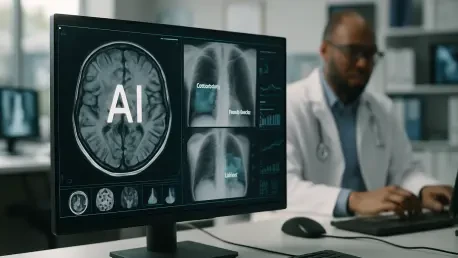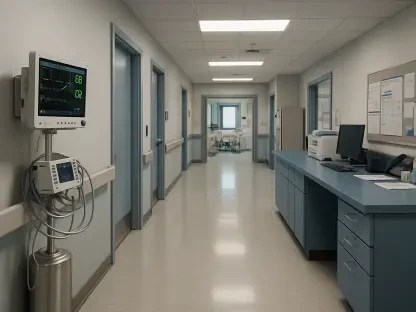Imagine a hospital where diagnoses are made with pinpoint accuracy, staffing shortages are a thing of the past, and doctors spend more time with patients than on paperwork. This vision is becoming a reality thanks to artificial intelligence (AI), a technology that’s rapidly reshaping healthcare. From enhancing medical imaging to optimizing workforce management, AI is tackling some of the industry’s most persistent challenges. Its ability to analyze vast amounts of data, automate tedious tasks, and provide actionable insights is proving invaluable. As healthcare systems grapple with rising costs and overburdened staff, AI offers a lifeline, promising improved efficiency and better patient outcomes. However, with such transformative potential come significant hurdles, including ethical concerns and technical risks. This exploration delves into five critical areas where AI is making a profound impact, highlighting both the remarkable benefits and the caution required for responsible adoption.
Revolutionizing Diagnostics with AI Imaging
Artificial intelligence is redefining the field of medical imaging and diagnostics, empowering clinicians to detect life-threatening conditions with unprecedented accuracy. By sifting through complex imaging data, AI identifies subtle patterns that might escape human observation, enabling earlier detection of diseases like cancer or strokes. This technology integrates smoothly with electronic health records (EHRs), ensuring that diagnostic tools complement existing workflows rather than disrupt them. The result is a significant reduction in errors, faster turnaround times for results, and enhanced trust among medical professionals who retain final decision-making authority. AI acts as a supportive partner, amplifying human expertise while addressing the critical need for precision in high-stakes environments where every second counts.
Beyond just accuracy, AI in diagnostics is reshaping how healthcare facilities manage their resources and prioritize care. Hospitals equipped with these tools can process imaging studies more efficiently, cutting down wait times for patients anxious about their results. This efficiency also alleviates pressure on radiologists and pathologists, who often face overwhelming caseloads. Moreover, by flagging urgent cases for immediate review, AI ensures that critical conditions are addressed promptly, potentially saving lives. While the technology doesn’t replace the nuanced judgment of trained professionals, it provides a vital layer of support, allowing for a more focused approach to complex cases. As adoption grows, the balance between machine assistance and human oversight remains a key consideration for sustainable integration.
Predicting Patient Risks with Advanced Analytics
AI-driven predictive analytics is transforming patient care by enabling healthcare providers to anticipate complications before they occur. By analyzing a wealth of data, including vital signs, medical histories, and lifestyle factors, these systems identify individuals at high risk for issues like hospital readmissions or chronic disease flare-ups. This foresight allows clinicians to intervene early, whether by adjusting treatment plans or increasing monitoring efforts. The impact is profound, as proactive care not only improves patient outcomes but also reduces the strain on overburdened facilities. Hospitals can better allocate resources, ensuring that attention is directed where it’s needed most, ultimately fostering a more responsive healthcare system.
Equally important is how predictive analytics supports long-term planning and operational efficiency within healthcare settings. By forecasting patient trends, such as potential surges in admissions, facilities can prepare in advance, optimizing bed availability and staff deployment. This data-driven approach minimizes preventable readmissions, a costly issue for many institutions, and enhances the overall patient experience through tailored care strategies. Furthermore, it shifts the focus toward prevention rather than reaction, aligning with broader goals of value-based care. While challenges like data privacy and algorithm reliability must be addressed, the potential of predictive analytics to save lives and streamline operations makes it a cornerstone of modern healthcare innovation.
Optimizing Workforce Management through AI
Staffing shortages have long plagued the healthcare industry, but AI is stepping in to offer innovative solutions that streamline workforce management. Advanced scheduling platforms powered by AI analyze patient demand and clinician availability to create balanced shift plans, reducing dependence on expensive external staffing agencies. These tools ensure that the right personnel are in place at the right time, minimizing burnout and maintaining quality of care. By automating a process that traditionally consumes significant administrative effort, AI allows hospital managers to focus on strategic priorities rather than logistical headaches, addressing a critical pain point in an industry often stretched thin.
In addition to scheduling, AI introduces cutting-edge efficiencies through technologies like voice-to-shift systems that simplify operational tasks. Such innovations enable administrators to convert spoken instructions or raw data into actionable shift postings with minimal effort, saving valuable time. This not only boosts productivity but also empowers facilities to retain control over their staffing processes. The ripple effect is felt across the organization, as reduced administrative burdens translate into more resources for direct patient care. While integrating these systems requires initial investment and training, the long-term benefits of a more agile and responsive workforce are undeniable, marking AI as a pivotal tool in solving systemic staffing challenges.
Easing Administrative Burdens with Documentation Tools
The administrative load on healthcare professionals is a well-known barrier to patient-focused care, but AI is changing the game with generative tools for clinical documentation. By converting real-time spoken interactions between clinicians and patients into draft notes for electronic health records, these systems drastically cut down on paperwork time. The accuracy of such technology means that only minimal review and editing are needed, freeing up hours that can be redirected toward meaningful patient engagement. This shift not only enhances job satisfaction among medical staff but also ensures that critical details are captured without delay, improving the quality of recorded information.
Beyond time savings, AI documentation tools contribute to a more cohesive and error-free record-keeping process, which is vital for coordinated care. Accurate and timely notes facilitate better communication among healthcare teams, reducing the risk of misunderstandings that could affect treatment plans. Additionally, by alleviating the frustration of repetitive tasks, these tools help combat clinician burnout, a growing concern in the field. As hospitals and clinics adopt such technologies, the focus shifts from cumbersome data entry to building stronger patient relationships. However, ensuring the security of sensitive information within these systems remains a priority to maintain trust and compliance with regulations.
Exploring the Future with Agentic AI Systems
Emerging on the horizon of healthcare innovation are agentic AI systems, which promise to handle complex operational tasks with minimal human intervention. Capable of autonomously adjusting schedules, managing supply chains, or reallocating resources based on real-time data, these systems could redefine efficiency. For instance, by predicting peak demand periods, agentic AI can ensure that staffing and inventory levels are optimized without manual oversight, reducing bottlenecks. Though still in early development, this technology hints at a future where backend operations run seamlessly, allowing healthcare providers to concentrate on clinical priorities rather than logistical challenges.
The potential of agentic AI extends to enhancing adaptability in dynamic healthcare environments where needs can shift rapidly. As these systems evolve, they could anticipate and respond to unforeseen disruptions, such as sudden patient influxes or equipment shortages, with swift adjustments. This level of automation holds promise for cost savings and improved service delivery, but it also raises questions about accountability and oversight. Striking a balance between machine autonomy and human control will be crucial to ensure safety and reliability. As research and testing progress, agentic AI stands as a testament to the boundless possibilities of technology in transforming healthcare operations.
Paving the Way for Responsible AI Integration
Reflecting on the journey of AI in healthcare, it’s clear that the technology has carved out a vital role in addressing longstanding issues, from diagnostic precision to workforce shortages. Each application, whether in imaging or autonomous systems, demonstrates a capacity to enhance efficiency and elevate patient care standards. Yet, the path is not without obstacles, as ethical concerns and technical risks demand careful navigation. The strides made in predictive analytics and documentation underscore a shift toward proactive, patient-centered approaches that prioritize both outcomes and clinician well-being. Looking back, the cautious yet progressive adoption of AI has laid a foundation for a more resilient healthcare landscape.
Moving forward, the focus must shift to actionable strategies that ensure AI’s benefits are realized responsibly. Healthcare facilities should prioritize pilot programs to test tools in controlled settings, gathering insights before full-scale deployment. Engaging clinicians in the design and selection of AI systems will foster usability and trust, while comprehensive training programs can build staff confidence. Additionally, robust policies on data security and accountability must be established to protect patient trust. As the industry continues to evolve, collaboration between technology developers and healthcare professionals will be key to harnessing AI’s potential while safeguarding the human touch at the heart of medicine.









